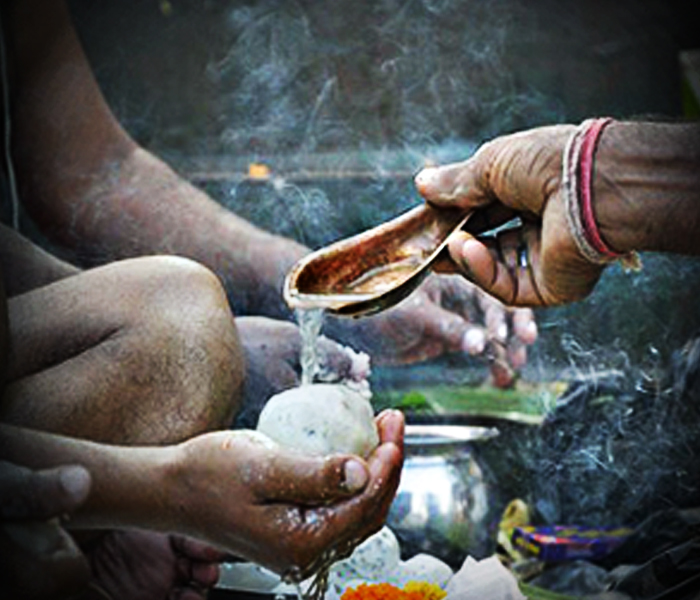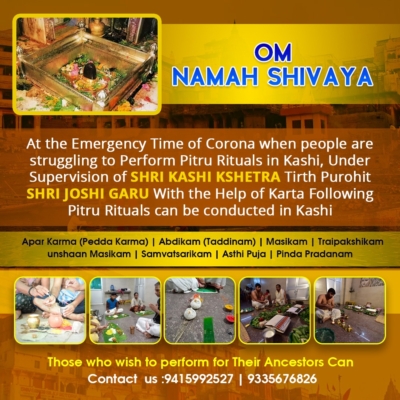At the Emergency time of Corona, Conduct Pitru Rituals in Kashi
Shradh’ is performed by a competent descendant of the deceased ancestors with shraddha or faith. Anna Shradh Varanasi or Gaya is performed for the benefit of three generations of ancestors viz. father, grandfather, and great-grandfather.
It has to be performed at the appropriate time (afternoon or aparahna) and place as determined by the Shastras and family traditions. Either cooked food or uncooked articles of food or gold or money are donated to worthy Brahmanas. Generally, for the majority of the people, Pind Daan in Gaya – offering cooked rice-balls to the pitrus is very important in this ritual. The entire ritual is then dedicated to Lord Narayana with a prayer of forgiveness for the faults that might have unknowingly crept in. Performing the Shradh in a holy place is supposed to be most fruitful, which is why most people prefer to perform Anna Shradh in Varanasi. It is believed that during the performance of Shradh, the pitrus (ancestors) accept the offerings by assuming the form of birds or by entering into the invitee (brahmana) through their subtle bodies.

What is Pitru / Mahalaya Paksha?
Pitru Paksha is the period of fifteen days when Hindus pay homage to their ancestors.
It specifically refers to the fifteen days of Krishna Paksha in the month of Bhadrapada (according to the lunar calendar) or the month of Ashwin (according to the solar calendar). This approximately corresponds to September-October in the Gregorian calendar.
This period is also referred to as Mahalaya Paksha. This period is most preferred for performing the post-death rites such as Pitru Tarpan, Shradh, Daan, etc. to the departed forefathers or ancestors. This is the time when people visit the Holy places to perform religious activities like Anna Shradh in Varanasi and Shradh at Gaya. It includes fifteen days of various rituals accompanied by offerings of food. It is believed that their spirits come to Earth to receive the offerings and to bestow their blessings. This is said to be powerful enough to change the destiny of those performing the rites.
To the performer, it is an expression of gratitude towards all those generations of ancestors who lived before us. This day falls on in the Lunar month of Bhadrapada that begins with the full moon day or the next day.
The last day of Pitru Paksha is regarded as the most significant day and it is known as Mahalaya Amavasya or Sarvapitri Amavasya.
Mahalaya Amavasya is the new moon day, the beginning of the bright lunar fortnight. The three generations of ancestors descend from Pitru Loka (a realm between Heaven and Earth) and reside with their present family from the day the Pitru Paksha begins, till the Mahalaya Amavasya. It is the final day of Pitru Paksha to make offerings to the ancestors and express gratitude for making our lives happy and healthy. Although the Shradh ritual is performed on all Amavasya (new moon day) days, suppose one misses out to perform on any or all other Amavasya, then performing on Mahalaya Amavasya reaches to the Pitru (ancestors) directly. Hence, one can be saved from Pitru-dosham even if one performs the Shradh on Mahalaya Amavasya alone with the Pandit for Shradh Puja or Best Pandit Services in Varanasi.
After Pitru paksha, the ancestors bless the family and proceed to the Pitru Loka peacefully and happily, marking the beginning of Navratri celebration.
Many families from different corners of the country make this pilgrimage to Holy places and perform Anna Shradh in Varanasi and Shradh at Gaya and offer Pinda to their ancestors.



